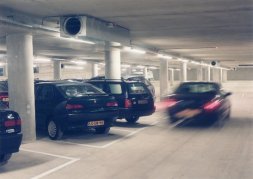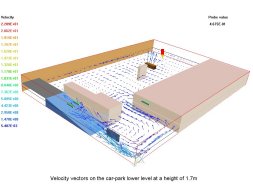| 软件升级6.0简介 | 绿建设计评价软件 V6.0 试用版 |
绿建设计评价软件 V6.0 正式版 |
新标准申报格式文本1 |
新标准申报格式文本2 |
| 会员专区 | 绿建条文 | 绿建清单 | 视频列表 | 下载中心 | 绿建产品 | 绿建学院 | 绿建服务 | 购买指南 |
-
地下停车场火灾烟雾模拟
时间:2014-02-13 14:28:04 作者:本站编辑 来源:绿建之窗 阅读:2639内容摘要:CFDisbeingusedincreasinglytocomplementtheengineeringdesignoffireandsmokeventilationsystemsrequiredtomeetfiresafetyregulations.TheuseofCFDtos...CFD is being used increasingly to complement the engineering design of fire and smoke ventilation systems required to meet fire safety regulations. The use of CFD to simulate smoke removal during fires allows design strategies for ventilation to be investigated for different scenarios before construction and installation. In particular the response of key components of the smoke control system, such as powered exhaust ventilation fans, ceiling-mounted jet fans and smoke curtains, can be examined in terms of facilitating fire fighting operations and maintaining clear escape and access routes.
fire safety regulations. The use of CFD to simulate smoke removal during fires allows design strategies for ventilation to be investigated for different scenarios before construction and installation. In particular the response of key components of the smoke control system, such as powered exhaust ventilation fans, ceiling-mounted jet fans and smoke curtains, can be examined in terms of facilitating fire fighting operations and maintaining clear escape and access routes.The CFD code PHOENICS 3.4 has been used by Rucon B.V.Ventilatoran to investigate the performance of a fire-protection system
 in the event of a car fire in an underground car park. The fire-protection system in the car park comprises a smoke-exhaust ventilation system with a number of strategically-placed jet fans that transport the air-smoke mixture towards the extraction fans. The system is intended to ensure the safe escape of the occupants from the various car-park levels by maintaining any smoke layer above the heads of the people. The PHOENICS model simulated two levels of the car park and included such details as ceiling-mounted ventilators, extract fans, columns, dividing and external walls, ramps and other internal structures. The task was to predict fire and smoke movement in the underground car park for a number of ventilation designs. PHOENICS was used to simulate a car fire on the lower level by means of a time-dependent source of heat and smoke; thermal radiation was modelled by means of the computationally efficient and pragmatic IMMERSOL model. The final design for fire containment employed jet fans on the upper level to force air down towards an extract fan located on the lower level.
in the event of a car fire in an underground car park. The fire-protection system in the car park comprises a smoke-exhaust ventilation system with a number of strategically-placed jet fans that transport the air-smoke mixture towards the extraction fans. The system is intended to ensure the safe escape of the occupants from the various car-park levels by maintaining any smoke layer above the heads of the people. The PHOENICS model simulated two levels of the car park and included such details as ceiling-mounted ventilators, extract fans, columns, dividing and external walls, ramps and other internal structures. The task was to predict fire and smoke movement in the underground car park for a number of ventilation designs. PHOENICS was used to simulate a car fire on the lower level by means of a time-dependent source of heat and smoke; thermal radiation was modelled by means of the computationally efficient and pragmatic IMMERSOL model. The final design for fire containment employed jet fans on the upper level to force air down towards an extract fan located on the lower level.The PHOENICS INFORM facility was employed to specify via the pre-processor a smoke-dependent gas emissivity. In addition INFORM was used by Rucon to introduce their own formulae for computing the volumetric smoke concentration and estimates of the local visibility. The advantage of INFORM is that it obviates the need for user FORTRAN and recompilation, and it also enables easy and flexible interpretation of the solution fields in an engineering framework.
 The PHOENICS analysis allowed optimisation and verification of Rucon's ventilation strategy. Rucon commented "We have used CFD to prove that in the case of a car fire on the lower level, smoke does not progress to the upper level by use of the right ventilation system and strategy. The reason and the big advantage we have by using PHOENICS, is the fact that we can predict the movement of air and smoke in a car park before something is installed. We can make the airflow visible and understandable."手机扫一扫,访问该文章
The PHOENICS analysis allowed optimisation and verification of Rucon's ventilation strategy. Rucon commented "We have used CFD to prove that in the case of a car fire on the lower level, smoke does not progress to the upper level by use of the right ventilation system and strategy. The reason and the big advantage we have by using PHOENICS, is the fact that we can predict the movement of air and smoke in a car park before something is installed. We can make the airflow visible and understandable."手机扫一扫,访问该文章
- 相关文章
-
-
08-02大型商业绿色建筑设计实践
-
绿建软件
本栏最新更新
-
12-28【课堂】101《绿建标准》2019第八章-评分项-8.2.8室外风环境模拟
-
12-13疫情后,如何让建筑自然通风是设计之重!
-
11-19绿色建筑的被动式自然通风设计方法
-
09-13疫情当下,绿色建筑中的自然通风有多重要
-
08-05Phoenics-室外风环境分析和室内通风模拟软件介绍
-
08-08推荐!绿建之窗风、热软件介绍
-
11-14WindPerfectdx前期操作基本流程
-
08-01STREAM 通用流体分析软件
-
05-08Fluent 6.3 流体分析软件
-
04-24绿建软件 建筑通风Vent软件简介
本栏推荐
阅读排行
通信地址: 北京市丰台区汽车博物馆东路1号诺德中心2期6号楼1201 邮编:100070 网站合作:QQ:1658253059 电话: 13693161205 18501126985
 京公网安备11010602007284号 京ICP备14061276号-3
51LA统计
京公网安备11010602007284号 京ICP备14061276号-3
51LA统计



























